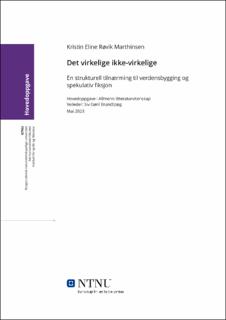| dc.contributor.advisor | Brandtzæg, Siv Gøril | |
| dc.contributor.author | Marthinsen, Kristin Eline Røvik | |
| dc.date.accessioned | 2023-09-22T17:19:26Z | |
| dc.date.available | 2023-09-22T17:19:26Z | |
| dc.date.issued | 2023 | |
| dc.identifier | no.ntnu:inspera:138868970:21205893 | |
| dc.identifier.uri | https://hdl.handle.net/11250/3091458 | |
| dc.description.abstract | Hva er spekulativ litteratur, og hva er verdensbygging? Dette er en strukturell tilnærming til disse spørsmålene som forsøker å kartlegge noen disse sjangrene i relasjon til tid og virkelighet. De tre spekulative sjangrene som her undersøkes i er dystopisk litteratur, sience-fiction og fantasy. Disse sjangrene vil bli kartlagt ut ifra deres relasjon til estetisk fortid og fremtid, samt hvor stor grad de prøver å etterligne en gjenkjennbar virkelighet for leseren. Felles for dem alle er at de inneholder en grad av verdensbygging. For å utarbeide denne sjangerkartleggingen brukes Tzvetan Todorovs metodikk for sjangerinndeling. Sjangerteoetisk tar oppgaven avstand fra Todorovs sjangerklassifiseringen om det ‘fantastiske’. Det fantastiske har hos mange blitt ansett som synonymt med fantasy, jeg vil argumentere at dette skyldes en feillesning av Todorov. Hans konseptuelle inndeling strekker heller ikke til for å klassifisere de moderne sjangrene som undersøkes her.
Oppgaven konstruerer en egen sjangerteori som bygges på konseptet verdensbygging.
For å utforske verdensbygging som konsept vil Eric Auerbachs Mimesis (1946) bli brukt for å vise hvordan man kan etablere en egen realisme i spekulative verker. Mikael Bakhtins «Forms of Time and of The Chronotope in The Novel: Notes Towards a Historical Poetics»(1937–38) blir brukt for å vise relasjonen mellom tiden og stedet i disse sjangrene, samt for å vise hvordan historiske kronotoper kan brukes som virkemiddel for å anvende en spesifikk tidsestetikk på handlingsrommet. | |
| dc.description.abstract | What is speculative literature and what is worldbuilding? This thesis is a structural approach to these questions and will try to map speculative genres with relation to time and reality. The three genres this thesis will analyse deeper is Dystopian fiction, Science-fiction and Fantasy. These genres will be compared according to their relation to a aesthetic past and aesthetic future. It will also compare them according to their relation and heteronomy to a reality the reader is familiar with. All three genres have world building as a common component. To make this genre categorisation I will use Tzvetan Todorov’s methods used in The Fantastic (1975) but the thesis rejects the often common misconception that the fantastic and fantasy is synonymous. I will argue that this comparison is due to a misreading of Todorov, and that his classifications are not sufficient to define the genres in which this thesis focus on. The thesis will construct its own genre-theory based on the concept of worldbuilding.
To explore the possibilities of worldbuilding I will use Eric Auerbachs Mimesis(1946) and show how speculative fiction can construct its own realism. To explore how time relates to space in speculative fiction, I will use Mikael Bakhtins «Forms of Time and of The Chronotope in The Novel: Notes Towards a Historical Poetics»(1937–38). This essay will also be used to show how historic chronotopes can be used to establish intra-aesthetic time in the story. | |
| dc.language | nob | |
| dc.publisher | NTNU | |
| dc.title | Det virkelige ikke-virkelige: En strukturell tilnærming til verdensbygging og spekulativ litteratur | |
| dc.type | Master thesis | |
